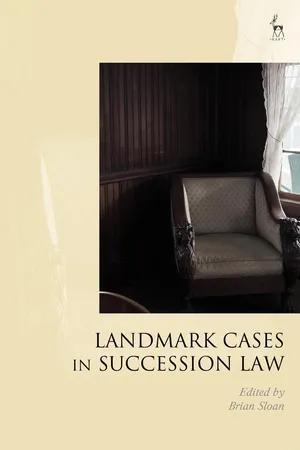
- 368 pages
- English
- ePUB (mobile friendly)
- Available on iOS & Android
Landmark Cases in Succession Law
About this book
The Landmark Cases series highlights the historical antecedents of what are widely considered to be the leading cases in a discipline, and seeks to provide contexts in which to better understand how and why certain cases came to be regarded as the 'landmark' cases in any given field. Succession law's long pedigree, near-universal application, immense capacity for human interest stories, somewhat uncertain future in England and Wales, and close connection to demographics make it an ideal candidate for a Landmark Cases volume. The distinguished contributors to this collection consider cases ranging from 1720 to 2017, covering issues such as will-making and interpretation, the position of beneficiaries and personal representatives, testamentary promises, and the extent of testamentary freedom in England and Wales and beyond. The cases are relevant not only to scholars and students of succession law per se, but also those working in fields such as tax, trusts, tort and land law. They raise issues as diverse as class, colonialism, familial dynamics, expectations and obligations, mental health, and the proper roles of the legal profession and the welfare state. The collection will provoke much discussion on what makes a 'landmark' case, as well as on the peculiarities and limitations of the case law method.
Frequently asked questions
- Essential is ideal for learners and professionals who enjoy exploring a wide range of subjects. Access the Essential Library with 800,000+ trusted titles and best-sellers across business, personal growth, and the humanities. Includes unlimited reading time and Standard Read Aloud voice.
- Complete: Perfect for advanced learners and researchers needing full, unrestricted access. Unlock 1.4M+ books across hundreds of subjects, including academic and specialized titles. The Complete Plan also includes advanced features like Premium Read Aloud and Research Assistant.
Please note we cannot support devices running on iOS 13 and Android 7 or earlier. Learn more about using the app.
Information
Table of contents
- Cover
- Title Page
- Preface
- Table of Contents
- List of Contributors
- Table of Cases
- Table of Legislation
- 1. Introduction
- 2. All Souls College v Codrington (1720): Money, Books and the Interpretation of Wills – A Testamentary Drama in Three Acts
- 3. Jesson v Wright (1820): Wills, Coal and the Rule in Shelley’s Case
- 4. Banks v Goodfellow (1870): Defining Testamentary Capacity
- 5. Re D(J) (1981): Statutory Wills
- 6. Hastilow v Stobie (1865): Lack of Knowledge and Approval
- 7. White v Jones (1995): A Legacy of the Search for Principle
- 8. Williams v Hensman (1861) and the Law of Severance: Janus Personified
- 9. Birmingham v Renfrew (1937): The Foundations of the Mutual Wills Doctrine
- 10. Sugden v Lord St Leonards (1876): Probate of the Missing Will – Hamlet Without the Prince?
- 11. Thorner v Major (2009): Proprietary Estoppel and Inheritance
- 12. Re Welch (1990): Enforcing Testamentary Promises
- 13. Strong v Bird (1874): Reassessing the Rule
- 14. Williams v Williams (1882): Succession Law Rules and the Fate of the Dead
- 15. Commissioner of Stamp Duties (Queensland) v Livingston (1964): Rights of Estate Beneficiaries and Trust Beneficiaries Compared
- 16. Gartside v IRC (1967): ‘This decision involved a small point’
- 17. Ilott v The Blue Cross (2017): Testing the Limits of Testamentary Freedom
- 18. S and S (2005): Compulsory Portion and Solidarity between Generations in Civil Law
- 19. Lashley v Hog (1804): Forced Heirship, and Succession across Borders
- 20. Re Estate Wilson, Deceased (2017): The Last Frontier for Aboriginal Intestacy in Australia?
- Index
- Copyright Page